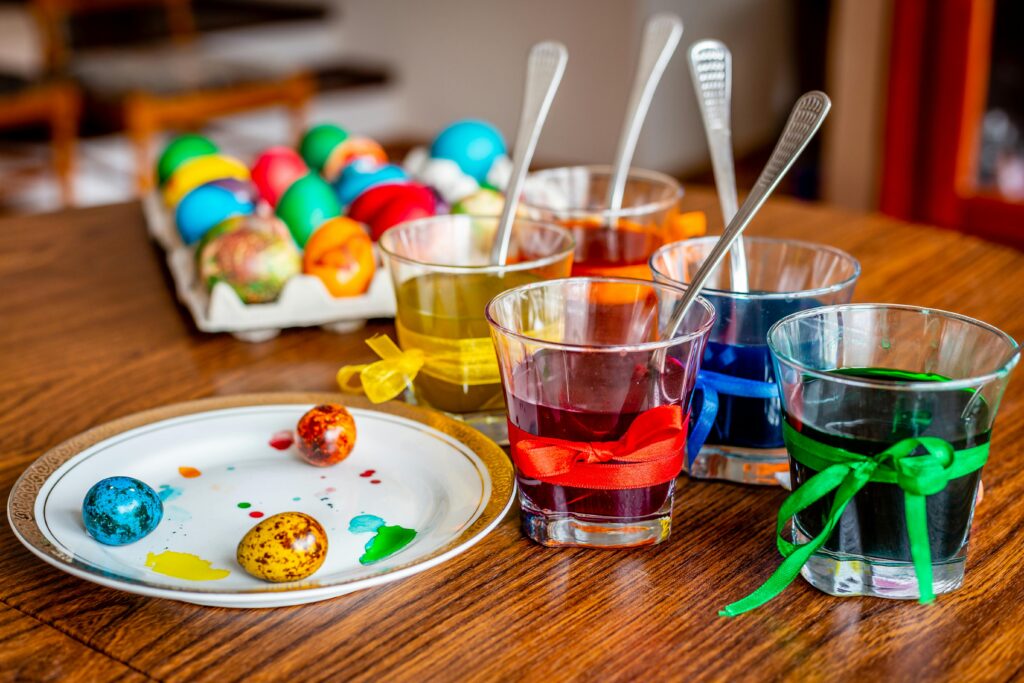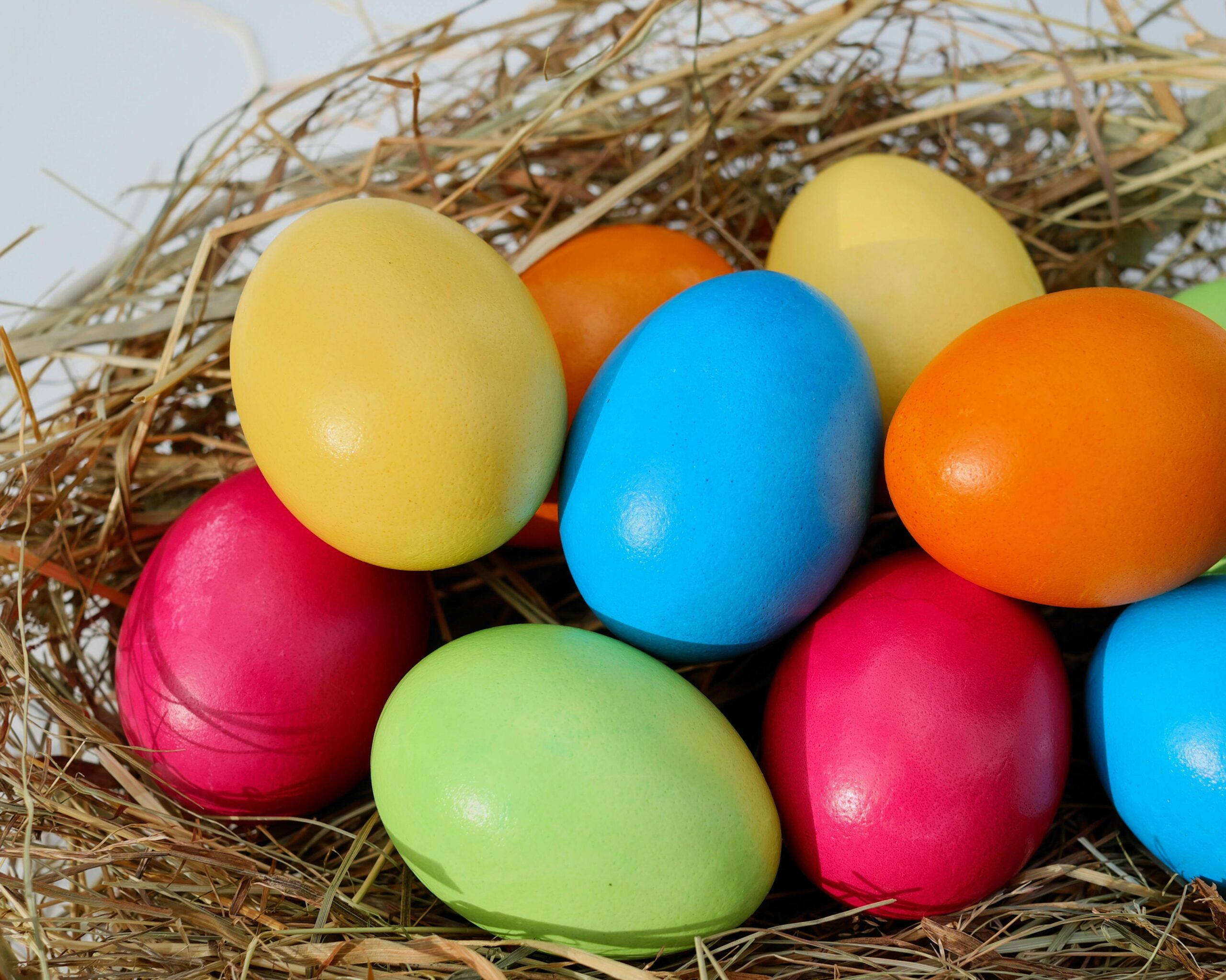Embarking on an egg-straordinary journey filled with hues that dazzle and designs that mesmerize, we delve into the enchanting realm of colored Easter eggs. As we gracefully glide through the artistry and craft behind these vibrant treasures, a burst of creativity awaits us at every turn. Imagine a world where each egg is a canvas waiting to be transformed into a masterpiece, where traditions blend seamlessly with innovation, giving rise to a kaleidoscope of possibilities. In this kaleidoscope, we witness a symphony of colors dancing harmoniously, each shade telling a unique story and carrying a special meaning. From the gentle pastels that whisper of spring’s arrival to the bold and daring tones that celebrate the joy of new beginnings, the art of coloring Easter eggs goes beyond mere decoration. It is a reflection of our culture, our creativity, and our unwavering spirit of celebration. Join us as we unravel the magic hidden within each shell, exploring the techniques, history, and endless inspirations that breathe life into these beloved symbols of the season. Step into a world where imagination knows no bounds, and let the allure of colored Easter eggs captivate your senses like never before.
The History of Coloring Easter Eggs
As we embark on our journey into the world of colored Easter eggs, it is only fitting that we begin with a glimpse into their rich history. The tradition of coloring eggs dates back thousands of years, with its origins rooted in ancient civilizations such as the Egyptians, Persians, and Greeks.
In these early cultures, eggs were seen as symbols of fertility and rebirth. They were often decorated and exchanged during spring festivals to celebrate the arrival of a new season and the renewal of life. The practice eventually made its way to Europe, where it became intertwined with Christian traditions surrounding Easter.
During medieval times, eggs were not only colored but also adorned with intricate designs using wax or natural dyes made from plants and vegetables. These decorative eggs were highly prized and given as gifts to loved ones or used in religious ceremonies.
Over time, the art of coloring Easter eggs evolved, influenced by different cultures and artistic styles. In Eastern Europe, particularly in countries like Ukraine and Russia, a technique known as pysanky emerged. This method involves using beeswax to create intricate patterns on the eggshell before dyeing it multiple times in various colors.
In Western cultures, egg dyeing became popular during the 19th century when synthetic dyes became more readily available. Families would gather together to dye eggs using vibrant colors and create unique designs using stickers or stencils.
Symbolism Behind Different Colors
Each color used to decorate an Easter egg carries its own symbolism and meaning. Understanding these meanings adds depth to the artistry behind colored Easter eggs:
– Red: Symbolizes the blood of Christ and represents love, sacrifice, and redemption.
– Yellow: Represents light, purity, joy, and new beginnings.
– Green: Symbolizes rebirth, growth, and the arrival of spring.
– Blue: Represents the sky and heaven, symbolizing hope and divine protection.
– Purple: Symbolizes royalty, power, and penance.
– Pink: Represents love, gratitude, and appreciation.
Traditional Techniques vs. Modern Innovations
The art of coloring Easter eggs has come a long way from its humble beginnings. While traditional techniques such as pysanky and natural dyeing methods still hold their charm, modern innovations have introduced new possibilities for creativity:
– Marbling: Using nail polish or oil-based paints to create a marbled effect on the eggshell.
– Decoupage: Applying decorative paper or fabric onto the eggshell using adhesive.
– Glittering: Adding sparkle to eggs by applying glitter or sequins with glue.
– Stenciling: Using stencils to create intricate designs on the eggshell before dyeing.
 DIY Egg Dyeing Methods
DIY Egg Dyeing Methods
If you’re feeling inspired to try your hand at coloring Easter eggs using traditional methods or modern techniques, here are a few DIY ideas to get you started:
1. Natural Dyeing: Boil eggs with natural ingredients such as onion skins (for orange), beets (for pink), spinach (for green), or blueberries (for blue).
2. Silk Tie Dyeing: Wrap eggs in silk ties or scarves and boil them to transfer the patterns onto the eggshells.
3. Melted Crayon Art: Use hot melted crayons to draw vibrant designs directly onto warm hard-boiled eggs.
Creative Egg Decorating Ideas
When it comes to decorating Easter eggs, the possibilities are endless. Here are a few creative ideas to spark your imagination:
1. Botanical Beauties: Decorate eggs with pressed flowers or leaves for a natural and elegant touch.
2. Animal-inspired Eggs: Transform eggs into adorable animals using paint, markers, or googly eyes.
3. Galaxy Eggs: Create a mesmerizing galaxy effect by blending different shades of blue and adding specks of white or silver.
 Unique Designs and Patterns
Unique Designs and Patterns
The art of designing Easter eggs knows no boundaries. From intricate patterns to bold geometric shapes, here are a few unique designs to inspire your creativity:
1. Moroccan-inspired Patterns: Draw intricate henna-like designs using fine-tipped markers or gel pens.
2. Ombre Eggs: Dye eggs in graduating shades of the same color for a stunning ombre effect.
3. Polka Dot Delight: Use round stickers or dotting tools to create playful polka dot patterns on the eggshell.
Easter Egg Hunts: A Timeless Tradition
No discussion about colored Easter eggs would be complete without mentioning the timeless tradition of Easter egg hunts. Dating back centuries, this joyful activity involves hiding decorated eggs for children to find and collect.
Easter egg hunts bring families together, fostering a sense of excitement and adventure as children search high and low for hidden treasures. The colorful eggs serve as rewards for their efforts, symbolizing the joy and abundance that come with the arrival of spring.
Cultural Significance of Colored Eggs
The cultural significance of colored Easter eggs varies across different regions:
– In Greece, red-colored eggs are exchanged as gifts to symbolize Christ’s resurrection.
– In Eastern European countries, intricately decorated eggs are displayed as a form of folk art.
– In the United States, Easter egg rolling is a popular tradition where children race to roll eggs down a hill using spoons.
Beyond Easter: Year-Round Egg Decorating Ideas
While colored eggs are synonymous with Easter, their beauty and charm can be enjoyed throughout the year. Here are a few ideas for decorating eggs beyond the Easter season:
1. Christmas Ornaments: Paint or decorate blown-out eggs and hang them on your Christmas tree.
2. Spring Centerpieces: Arrange colored eggs in a decorative bowl or nest as part of your springtime table centerpiece.
3. Wedding Favors: Personalize eggs with the names of guests and use them as unique wedding favors.
Conclusion: The Timeless Charm of Colored Easter Eggs
The magic of colored Easter eggs lies not only in their vibrant hues and intricate designs but also in the stories they tell and the traditions they uphold. From ancient civilizations to modern-day celebrations, these humble treasures continue to captivate our hearts and ignite our creativity.
As we celebrate the joyous arrival of spring, let us embrace the artistry behind coloring Easter eggs and create memories that will last a lifetime. Whether you choose traditional techniques or innovative methods, may each stroke of color bring you closer to the enchanting world of colored Easter eggs.


